A Private Tour today. With mobility limitations we wouldn’t be able to walk too far today, but that never stops us from getting out and seeing a great selection of birds. It was a lovely day to be out too – bright with sunny intervals in the morning and light winds. Perfect weather to be out birdwatching on the coast.
Our main destination for today would be Titchwell – with a mixture of hides and benches there are lots of places to stop. As we walked in from the car park, we could hear Long-tailed Tits in the sallows and we sopped to watch them working their way though the branches. A Coal Tit appeared in the alders above our heads too.
When we got to the Visitor Centre, we stopped for a quick look at the feeders out front, where Greenfinch, Goldfinch and Chaffinch were all added to the day’s list. We could hear the distinctive sound of a large flock of Pink-footed Geese calling as they flew over somewhere over towards the road, and we eventually caught sight of them through a gap in the trees as they disappeared off towards Thornham. A couple of Common Buzzards circled up over the trees too, enjoying the morning sunshine.
After a quick look in the sightings book to check what had already been seen this morning, we walked out of the door on the far side of the Visitor Centre. There were lots of Goldfinches in the tops of the alders here and, looking up, we spotted a smart male Brambling in with them. It dropped down through the branches, stopping for a minute in the sunshine where its bright orange breast glowed in the light.
Then the Brambling dropped again and seemed to head right down to the ground. We found it round on the far side of the gazebo, feeding on the path just a few metres from everyone stood there looking at the feeders. It was a great view of it as it picked its way around in the fallen leaves.

Continuing out to the main path, we had just started to scan the ditches when we notice a couple of people standing further up, staring down to the side of the path. Sure enough, they were watching the Water Rail. It was hard to see under the tangle of branches at first, although the movement as it tossed the leaves aside looking for food gave it presence away.
Then it moved out into the open where we could see it better, its long red-based bill, slaty-blue underparts and black-streaked brown upperparts. Water Rails are typically very secretive birds but this is always a good place to look for them through the winter and this one seemed completely unconcerned by the small crowd which quickly gathered to watch it.
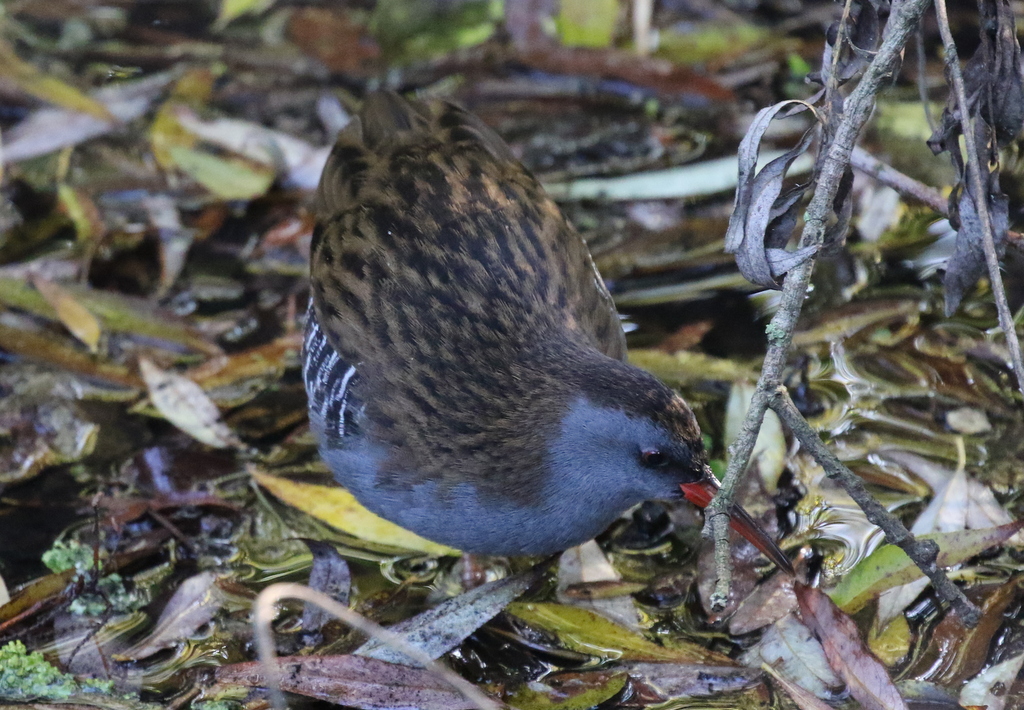
Out of the trees, as we walked along beside the reedbed, a Cetti’s Warbler shouted at us from deep in the vegetation. A few people had stopped to watch a Marsh Harrier out over the saltmarsh the other side of the path, and as we passed them we heard the shrill call of a Kingfisher from the reedbed. It flew up out of the reeds and perched briefly in one of the small sallows, just long enough for everyone to get onto it before it was off again. A flash of electric blue as it shot away up the channel through the reeds.
The reedbed pool held a small group of Tufted Ducks and a pair of Mallards and a single juvenile Mute Swan and a few Coot were in the surrounding channels. A little further on, a single Grey Plover and a Redshank were out on the Lavender Marsh pool. A Little Egret preening out on the saltmarsh too really stood out, whereas the slaty-grey Brent Geese were much better camouflaged.
When we turned round to look behind us, we spotted a Great White Egret flying in from the east, over the reedbed. Even though it was silhouetted against the light and it was hard to see its yellow bill, its large size was immediatey obvious, with slow, deliberate wingbeats and long trailing black legs. It flew over the path behind us and we watched as it disappeared off west, towards Thornham.

It was all action out here on the main path, and we hadn’t even got to the Freshmarsh yet! A Marsh Harrier had been quartering out over Thornham Point earlier but the next time we looked out that way three Red Kites were circling over the bushes. They were busy chasing each other and it seemed like perhaps they had found some food as one dropped something and the other two swooped down after it, one of them catching it again. They were then joined by two Marsh Harriers and they call circled together – the raptors were obviously enjoying the good weather!
Finally we made it down into Island Hide and a welcome chance to sit down. There were lots of Teal feeding on the mud just outside the hide, several of the males now starting to look very smart in their regained breeding plumage, the sun catching their bright green speculums.
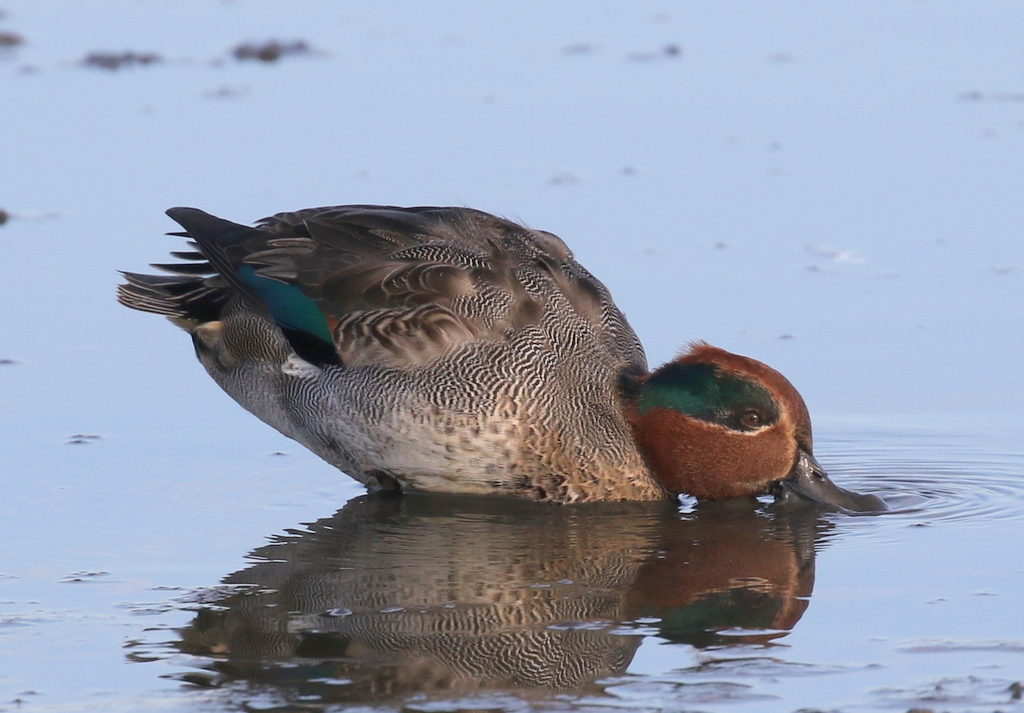
Further back, there were lots of Shoveler, mostly asleep. A closer pair were busy feeding, swimming round with their heads permanently down in the water, hiding their distinctive huge bills. There were a few Shelduck out on the water too, but most of the Wigeon were right over the far side, in front of Parrinder Hide.
There was a nice selection of waders too. On the nearest island, a large number of what at first sight seemed to be lumps of mud were actually hundreds of Golden Plover. Through the scope, we had a better view, their golden-spangled upperparts catching the sunlight. They feed inland in the fields, but come on here to roost or when disturbed, so they were mostly asleep.

Further back, a line of white shapes all standing on one leg in the deeper water were Avocets. There are still a good number here, even if a lot of them have already moved off south for the winter. A handful were awake and busy feeding nearby, sweeping their distinctive bills back and forth through the water. There were a few gulls in a line on the end of the Avocets – mostly Black-headed Gulls, with their winter black dot behind the eye, and a single Common Gull too.
On the other end of the Avocets was a smaller group of large grey waders, which through the scope we could see were Bar-tailed Godwits. A single Knot was hiding in amongst them and a Ruff appeared with them too. More waders were flying in all the time – it was going to be high tide soon, so birds were coming in from the beach to roost. More Bar-tailed Godwits and a couple of Turnstones dropped in too. There were a few Dunlin scattered around the islands too.
A Water Pipit called as it flew in and dropped down at the edge of the reeds. Unfortunately it didn’t stop long and flew off over the hide. Thankfully, a short while later it reappeared and dropped down on the mud again. This time we could get it in the scope – grey above and off-white below, marked with clean black streaks. From back out on the main path, we could see two more Water Pipits on one of the islands in the middle of the Freshmarsh, along with a much swarthier Rock Pipit and a couple of Pied Wagtails.
We had a better view of the Dunlin from up here, with a couple feeding on one of the smaller muddy islands just below the bank. A small flock of Knot flew in from the beach and dropped in to bathe in the shallow water. There were a couple of Lapwings out on the islands further back too. A single Greylag Goose was busy preening on one of the islands below us too. A succession of small groups of Brent Geese commuted in and out from the saltmarsh behind us, coming in to bathe.
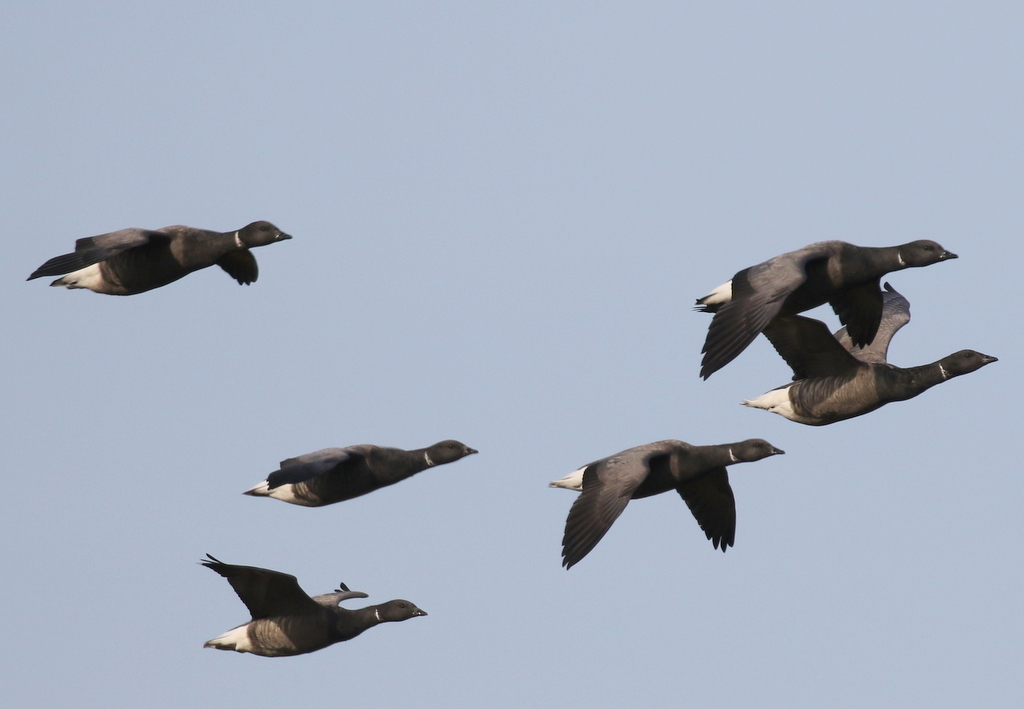
We made our way slowly round to Parrinder Hide. An Avocet was feeding in front of the hide, giving us a much closer look. Two Common Redshank were in the water to the left of the hide too and there were three more Ruff on the edge of one of the closer islands.
There were more ducks right in front of the hide here, at least until a Marsh Harrier drifted over and flushed everything, but we still had a better view of a couple of the Wigeon feeding on one of the islands. The harrier flushed all the Golden Plover too, which whirled round above the water in a tight flock before settling back down, calling noisily.
One of the Water Pipits was still feeding out on the short vegetation on the big island to the right of the hide, and it was a great, closer view of it from here, even if we were looking slightly into the light – one of the drawbacks of a sunny day!
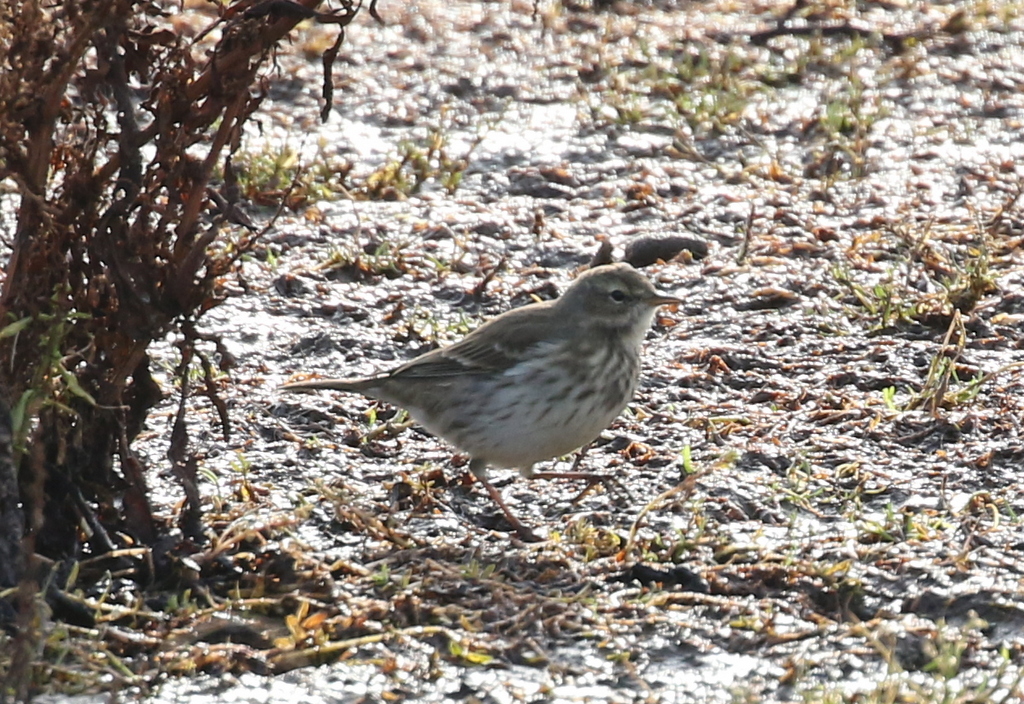
Time was already getting on, so we decided to start to make our way slowly back for lunch. There were still a few more distractions on the way – another Red Kite circled over the reedbed and when we got back to the trees, a few Siskins were feeding high in the alders above the path with the Goldfinches.
We stopped for lunch back at the Visitor Centre. When the Grey Squirrel wasn’t occupying the one feeder, a succession of finches and tits kept coming in and out. One or two Bramblings came in to feed on the ground below, with the Woodpigeons and Moorhens.
It felt like we had pushed the limits a little of how far we should walk today already this morning, so we decided on a more relaxed afternoon. Back to the minibus, we drove round to Thornham Harbour next. A Rock Pipit was perched on the gunwale of one of the old boats by the coal barn – looking very different to the Water Pipits we had been watching earlier.
There was still quite a lot of water in the harbour channel, but the muddy edges held four godwits – three Bar-tailed and a single Black-tailed Godwit with them. From the minibus, we had a great look at them feeding together, the Black-tailed Godwit darker, grey backed and longer-legged compared to the Bar-tailed Godwits.
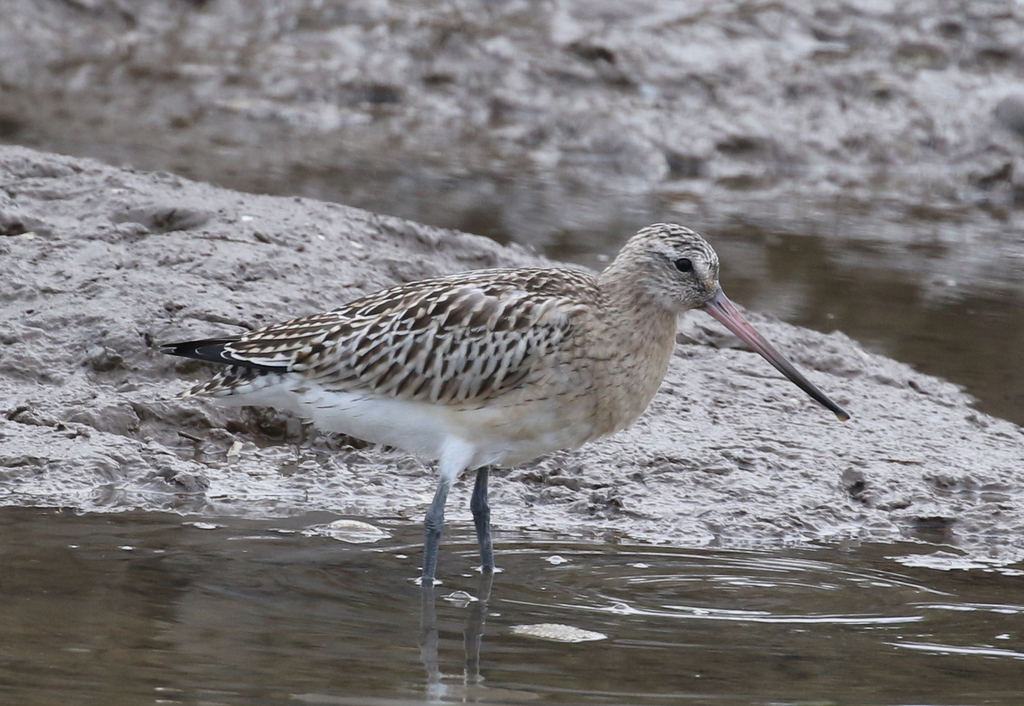
A large flock of Linnets flew up from the saltmarsh and whirled round. There are a small number of Twite back already for the winter, but we couldn’t see them with the Linnets – just a few Goldfinches. We weren’t getting out to look for them this afternoon, so we moved on.
From Thornham, we drove inland on some of the smaller roads. We had seen some Pink-footed Geese dropping down this way earlier, so we thought we would have a quick look for them. There were lots of Pheasants and Red-legged Partridges in the road – the shooting season has only just begun and there are still loads of the birds released this year running around and they seem to like sitting in the roads!
A seed mix strip on the side of the road held lots of finches, including a large number of Greenfinches which is always good to see given how they have declined. A little further on, and we spotted a small group of Pink-footed Geese flying in. We stopped and watched as they whiffled down towards a distant recently-harvested sugar beet field. We could see lots more geese down on the ground already, a couple of fields over, through a gap in the hedge, so we decided to drive round to see if we could get a closer look.
When we got round to the other side, a large flock of Fieldfares flew up from the field, beside the road. The Pink-footed Geese had cleverly picked a part of the field to feed in which was mostly hidden from here, but we could see several up on the ridge, their dark heads and small mostly dark bills very different from the Greylag we had seen at Titchwell earlier.
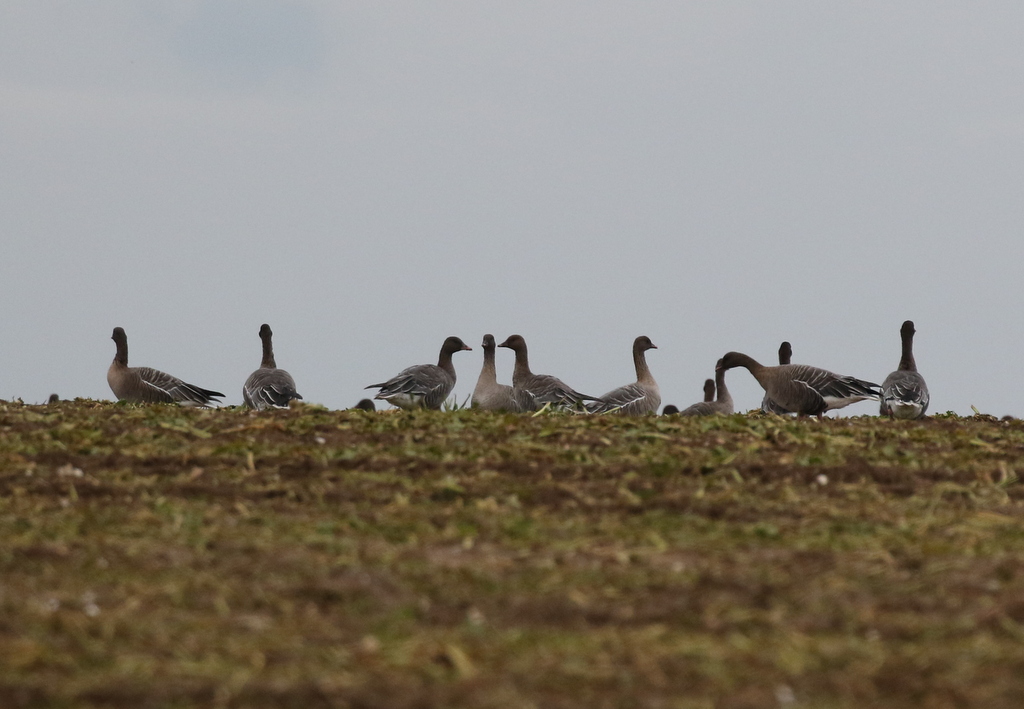
A lone Egyptian Goose was in the field too, feeding on its own but it walked off towards the Pinkfeet as we drove up. A little further on, a Common Buzzard was perched out in the same field. From a gap in the hedge, we could see the winter wheat field the other side of the road was full of gulls, Lapwings and Golden Plover. A single Brown Hare was in amongst them all.
Looping back down to the coast road, we headed for Brancaster Staithe. As we drove down to the harbour, the tide was still just going out and a Little Egret was feeding in the flat calm water just off the shore.

From the comfort of the minibus we could see a nice selection of waders. Several Oystercatchers and Ringed Plovers were standing around on a muddy island out in the water. Over the other side of the channel, we could see several more Bar-tailed Godwits. Someone was washing mussels over on one side of the harbour, and as he walked away from the pile of shellfish landed on the shore, loads of Turnstones hurried in to see what they could fined amongst them.
A few Brent Geese were down in the water just on the edge of the parking area and several Pied Wagtails were running around on the stones, gathering here ahead of heading off to roost together. A sign that time was getting on, and the light was already beginning to go. It was time to head back.
Even on the way, we had a few more surprises. Four Red Deer were feeding in a stubble field, inlcuding one stag with a fine set of antlers. A little further on, we pulled up by a gateway to find a Common Buzzard feeding on a dead rabbit just a few metres away, with a second Buzzard on the gatepost beside it.
It had been a great day – and a good demonstration of how you don’t necessarily need to walk too far to see lots of wildlife along the coast here.
















